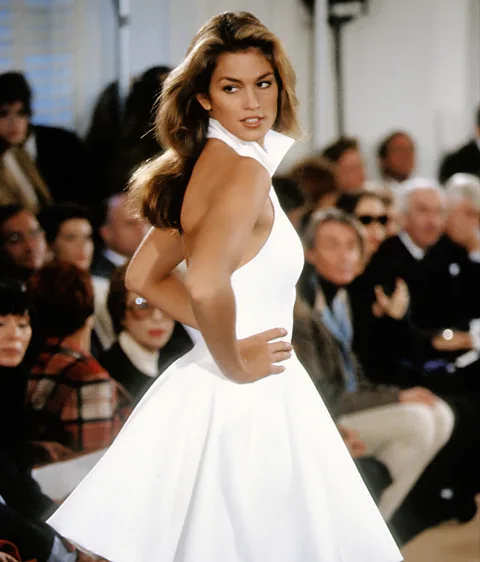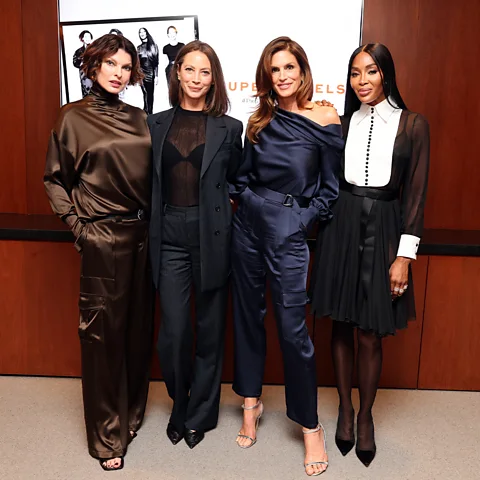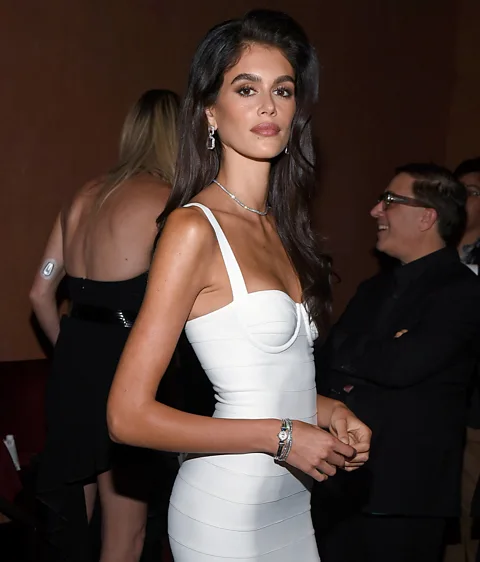 Serenity Strull/ BBC/ Getty Images
Serenity Strull/ BBC/ Getty ImagesAs fashion month continues, the trailblazing supermodel talks 90s nostalgia, career gambles, and embracing getting older.
It’s hard to picture Cindy Crawford being scared. The supermodel’s signature gaze is pretty fearless, after all, with direct eye contact and a slight smile that makes Crawford look like she’s always remembering a very good joke. But just before the iconic model turned 35 in 2001, she felt “a bit frightened”.
“I had been on contract with Revlon for nearly 13 years,” Crawford tells the BBC from her home in Los Angeles. “They were wonderful to me. But models did not last past 35 back then. That was just the industry thinking at the time.” As her million-dollar beauty contract came up for renewal, tabloids called Crawford “too old,” even as they sent paparazzi to photograph her every move for their covers. She had just given birth to her daughter, the now-famous Kaia Gerber. Her first child, Presley Gerber (now also a model), was a toddler. “And I was like, ‘Okay, am I going to just ride off into the sunset? Or am I going to bet on myself, and try and do my own thing?’ I just knew I had to take a chance on myself,” she says. “It was a gamble.”
 Getty Images
Getty ImagesBut Crawford is something of a mastermind when it comes to career gambles. In the fashion world, she’s long played master poker when others are yelling “Uno!” A midwestern catalogue model turned European runway bombshell, Crawford was one of the first models to work with luxury and mass brands simultaneously, starring in a 1991 Pepsi commercial, while also storming catwalks for Ralph Lauren and Versace. In 1996, she posed nude for Playboy, while serving as the face of luxury watch brand Omega. Her years on MTV’s House of Stylehelped turn Paris couture into pop culture.
Today, such high-low swoops are commonplace. Gigi Hadid is the face of Victoria’s Secret and Miu Miu; Kendall Jenner reps Uber Eats and Calvin Klein. Crawford blazed that trail while wearing Chanel heels and a Hanes undershirt.
Starting a makeup brand would have been an easy move for the model who convinced millions of women to wear dodgy brown lipstick in the 90s. But Crawford had something different in mind: she wanted to explore a then-nascent trend called “French-girl beauty”, and enlist her Parisian dermatologist Dr Jean-Louis Sebagh to help. “We didn’t have a word for it then – there was no social media,” Crawford explained. “But in 2001, there was this idea about how French women look so great when they age, and how they take care of themselves, and how they’re so chic. And I was like, ‘I know how they are! It’s Dr Sebagh!'”
 Getty Images
Getty ImagesCrawford also respected, and agreed with, Sebagh’s “don’t panic” approach to 30-something skin. “He calls his work age-maintenance. It’s a realistic thing. You’re taking care; you’re trying to look as good as you can for as long as you can – you’re not fighting against the years that you’ve earned.” Together, they decided to bottle Sebagh’s anti-oxidant facial formula, which Crawford first used at the doctor’s Paris clinic. They named it Meaningful Beauty, and spoke with luxury department stores before launching the product themselves – with an infomercial.
Super troupers
“It was really important that Meaningful Beauty be accessible to everybody,” says Crawford. “And look, beauty tutorials and TikToks are basically just little infomercials, right? Back then, an infomercial meant, like, crappy ginsu knives.” Now, direct-to-consumer beauty lines are normal, and branded video is standard. Meaningful Beauty has created theirs with Gen-X celebrity friends like Grey’s Anatomystar Ellen Pompeo, 54, and Sex and the City’sKristin Davis, 59.
Meanwhile, Crawford herself has become something of a television star, thanks to the Apple TV+ 2023 docuseries The Supermodels. The show chronicled the rise of Crawford, along with Naomi Campbell, Linda Evangelista and Christy Turlington. “I don’t think people realise how weird we looked to the fashion industry at the time,” says Crawford. “I’m serious! The generation before us was all blonde girls with blue eyes. They called them ‘All American,’ even though obviously, American is so, so much more. In that environment, we were broadening the idea of beauty. Doesn’t that sound crazy now?”
 Getty Images
Getty ImagesCrawford said the show was successful enough that TV executives are discussing a season two. “I’ve been wondering, ‘If we do this, what’s the fashion story we want to tell next?’ And I look at what’s happened in fashion, and it’s been amazing. We have a much wider variety of skin colours, of sizes, of nationalities, of ages. So I said, ‘If we do this [Apple] show again, we have to keep championing that beauty has many different facets.'”
The Changing Room
The Changing Room is a column from the BBC that spotlights the fashion and style innovators on the frontlines of a progressive evolution.
And also some of the same facets. Case in point: Crawford’s 23-year-old daughter Kaia Gerber, who looks near-identical to her famous mother in photographs, and sometimes wears her past runway looks on various red carpets. Last week at the Toronto Film Festival, Gerber wore a white Hervé Léger bandage gown – a re-creation of her mother’s famous Oscars dress from 1993. “I never thought trends would return like that,” says Crawford of the sudden hunger for 90s style.
 Getty Images
Getty ImagesBut Crawford has less interest in revisiting the past than figuring out what, exactly, she’s going to do tomorrow. “I’ve started giving longer speeches on issues I care about – 45-minute speeches – and that’s a big challenge.” Crawford is also discussing new business ideas with her husband Rande Gerber, who co-owns the billion-dollar Casamigos tequila brand with George Clooney. “We have very, very different brains. We bounce things off each other. We don’t always get each other’s ideas, but we get each other.”
And Crawford still models, currently for both Donna Karan and Good American. “Honestly, I had no idea I would still even be getting my picture taken at this age,” she says. But wait, didn’t people claim Crawford was “too old” for international fashion campaigns after 35?
“I mean,” she says, laughing. “I guess they were wrong.”






